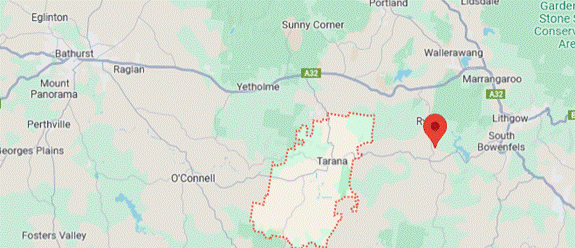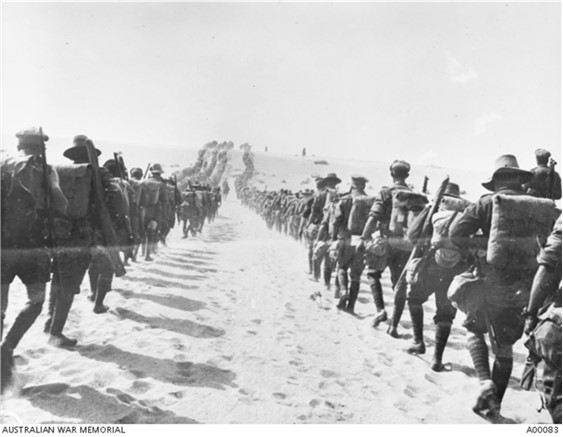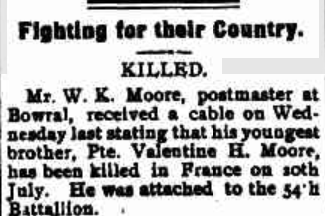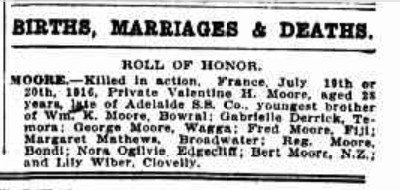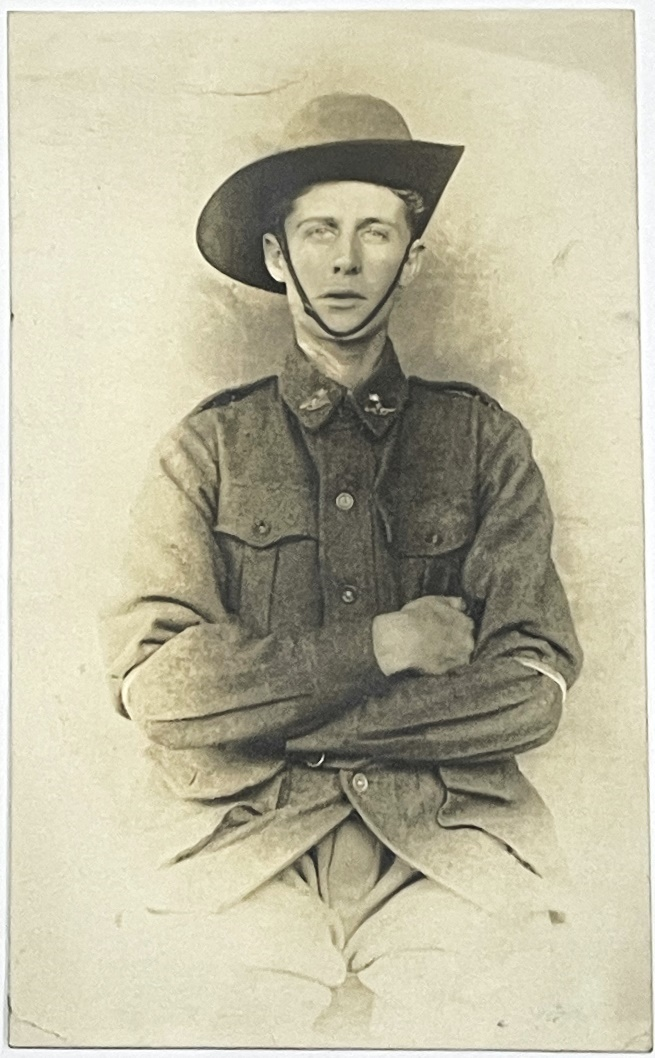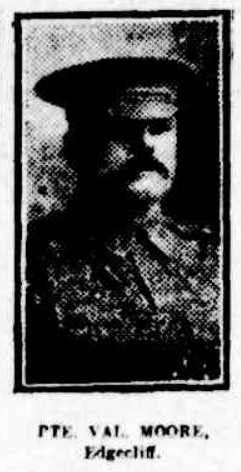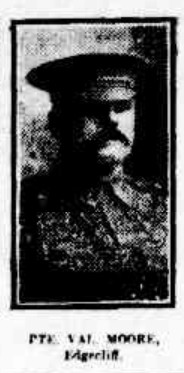
Valentine Harden MOORE
Eyes blue, Hair black, Complexion fresh
Valentine Moore –A treasured friend
With thanks to Lauren Thearle for her contribution towards this story.
Can you help us identify Valentine “Val” Moore?
Val was killed in action at Fromelles. As part of the 54th Battalion, there is a real chance Val may be one of the unidentified soldiers buried at Pheasant Wood, but we need help.
In 2008, a mass grave was found at Fromelles — dug by the Germans for 250 Australian soldiers recovered after the battle. As of 2024, more than 180 of these men have been identified by DNA. Val is still waiting.
If you know of any relatives from the complex Dunlop, Moore, Wightman family in Australia — please contact the Fromelles Association.
Early Life
Valentine “Val” Harden Moore was born in 1888 in Tarana, a small township in central-western New South Wales. He grew up in a large and complex family shaped by migration, hardship, and resilience.
Val’s mother, Jane Annabel Wightman, was born in Donegal, Ireland, in 1848 and immigrated to Victoria as a young woman. In 1866, she married John Thorn Dunlop, a Scottish immigrant. Together they had four children:
- John Wightman Dunlop (1868)
- Florence Mary Victoria Dunlop (1870, died at birth)
- William Kennedy Dunlop (1872)
- Gabriella Jane Dunlop (1874)
In 1875, John Dunlop was charged with wife desertion. Jane left Victoria with her three youngest children, eventually settling in New South Wales. Her eldest son, John Wightman Dunlop, remained in Victoria. Records suggest he married and had children, building his own life separate from his mother and siblings.
Once in NSW, Jane began a new life with Thomas James Moore. There is no record of their marriage, but together they had at least eight children:
- George Moore (1876–1918)
- Frederick Southwell Moore (1879 -1942) born in Lithgow
- Margaret Geraldine Moore (1879–1962), born in Lithgow
- Reginald Thomas Moore (1881–1945), born in Lithgow
- Nora Kathleen Moore (1885–1958), born in Oberon
- Herbert Moore (b. 1887)
- Valentine Harden Moore (1888–1916), born in Oberon
- Lily/Lilian May Moore (b. 1891), born in Oberon
Thomas Moore worked at the Lyceum Hotel in Pitt Street, Sydney, where he died in 1897. Jane outlived him by thirteen years, passing away in March 1910 at Greenwich, NSW.
Val attended Fort Street School in Sydney, but family records and electoral rolls place him first in Oberon, then later in Glebe, Sydney. Unlike many young men of his time who worked on farms or in trades, Val chose a life at sea, becoming a chief steward on coastal steamers. His work took him from port to port, managing supplies and passenger welfare – a role requiring responsibility, trustworthiness, and resilience.
Val was especially close to the Krogman family – May Krogman and her son, Arthur Stanley Krogman, who lived nearby. They shared holidays and it is likely that May and Val were in a defacto relationship, however that cannot be verified, some records refer to Val as Arthur’s Uncle and others as a friend. Either way, their bond led them both to enlist in 1915 and ultimately to fall side by side at Fromelles.
Off to War
Val enlisted on 27 August 1915 at Warwick Farm, NSW, at the age of 27. At the time, he was working as a chief steward on coastal steamers, a role that had taken him up and down Australia’s eastern seaboard. Despite having no prior military experience, Val was eager to serve. He embarked from Sydney on 20 December 1915 aboard HMAT A60 Aeneas as part of the 13th Reinforcements for the 1st Battalion.
He was allotted to and proceeded to the 54th Battalion from the 1st Training Battalion at Zeitoun, Egypt, on 16 February 1916, joining them at Tel el Kebir the same day. In early 1916, major reorganisations were underway following the heavy losses at Gallipoli and the arrival of thousands of new recruits from Australia.
The 54th Battalion was formed at Tel el Kebir in mid-February. Training continued in musketry, bayonet use, and unit drills to prepare the men for the Western Front. By the end of March, the troops marched approximately 60 km to Ferry Post, carrying their possessions and 120 rounds of ammunition each. The journey through soft sand in 38°C heat was a test of endurance, and upon arrival, the men were rewarded with a swim in the Suez Canal.
During this march, they were visited by H.R.H. the Prince of Wales, whom they greeted with “enthusiastic cheers.”
Source: AWM4 23/71/2, 54th Battalion War Diaries, March 1916, p. 13
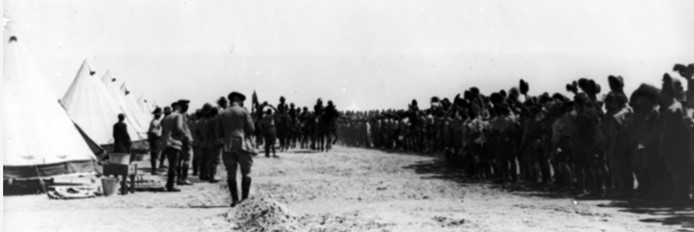
In May, the 54th Battalion was stationed in the front-line trenches at Katoomba Heights, eight miles from the Suez Canal. The following month, they received orders for France. On 20 June 1916, Val, one of 982 men of the 54th Battalion embarked on the Caledonian for their ten-day voyage to Marseilles via Malta. After arriving in France, they endured a three-day train journey to Hazebrouck, about 30 km west of Fleurbaix. By early July, they were billeted in barns, stables, and private homes in Thiennes, preparing for their first major battle on the Western Front – Fromelles.
On 10 July they moved to Sailly-sur-la-Lys and entered the trenches for the first time on 11 July. After a few days, they returned to billets in Bac-St-Maur.
Writing home on 15 July, Major Roy Harrison reflected sombrely:
“The men don’t know yet what is before them, but some suspect that there is something in the wind. It is a most pitiful thing to see them all, going about, happy and ignorant of the fact, that a matter of hours will see many of them dead; but as the French say ‘C’est la guerre’.”
An attack was planned for 17 July but delayed by bad weather.
BATTLE OF FROMELLES
On 19 July 1916, Val and his friend Arthur Krogman went into their first – and last – major battle on the Western Front. Neither was ever seen alive again. Sergeant Major F.C.R. Small described Val’s death:
“He was badly shot up at Fleurbaix on the night of July 19th, by my side. A piece of high explosive hit him in the head and he died almost immediately. I saw his dead body afterwards.”
4288 Pte Alfred Ernest East, 54th Battalion stated on Arthur’s Red Cross file:
At Fromelles 19th July 1916: Killed when we were going over the top. I was a few yards away when he was killed. He and Val Moore his uncle were killed by same shell. I was wounded and taken away. I knew him very well, he comes from Balmain. We called him Snowy.
Private Small noted in his statement that just in front of the German Wire, Val was killed alongside him, very close to the German trenches.
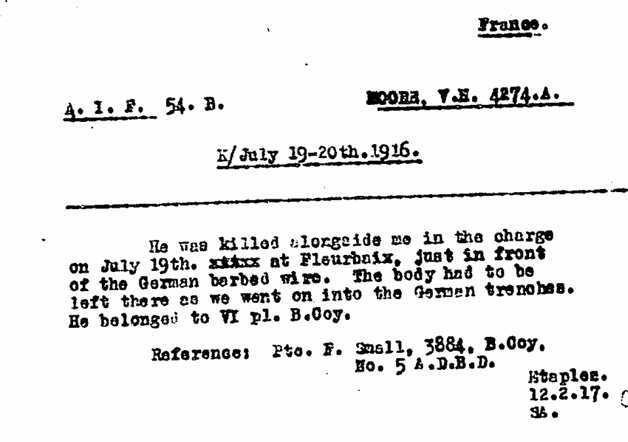
The Attack begins
By 19 July, orders came through to commence the assault that afternoon. The Australian objective was to capture a section of the German trenches to the left of the heavily fortified Sugar Loaf salient, which bristled with machine guns and dominated the surrounding ground. At 5.50 PM, the 54th Battalion began leaving their trenches in four waves. Half of A and B Companies advanced in the first two waves, followed by C and D Companies in the third and fourth. Unlike some attacks, the first waves did not immediately charge the German lines.
Instead, they moved out into No-Man’s-Land and lay down to wait for the British artillery bombardment to lift. At precisely 6.00 PM, whistles blew along the line, and the men rose to charge. The 54th faced ferocious artillery, machine gun, and rifle fire. Yet, despite heavy casualties, they managed to reach and overrun the German first and second line trenches. The 14th Brigade War Diary recorded:
Very few living Germans were found in the first and second line trenches.
Holding ground under fire
What they found were barely trenches at all – many were simple drainage ditches, half-filled with water and mud, offering little cover. Hastily, they tried to fortify their position, digging deeper and reversing the parapets to face the German rear trenches. They linked up with the 53rd Battalion on their right and with the 31st and 32nd Battalions further down the line. However, the 60th Battalion on their far right was unable to advance due to devastating machine gun fire from the Sugar Loaf, leaving the entire flank exposed.
Throughout the night, the Germans counterattacked relentlessly. With flares lighting No-Man’s-Land, machine guns raked any movement, and grenades rained down into shallow trenches crowded with wounded and dead. Supplies and reinforcements failed to arrive in sufficient numbers, and communications broke down in the chaos.
The tragic withdrawal
By dawn on 20 July, orders were given to withdraw. The retreat was disorganised and deadly. As the Australians pulled back across No-Man’s-Land, German artillery and rifle fire cut them down in waves. The exposed right flank had allowed German forces to infiltrate behind the 54th and 53rd Battalions, forcing them to fight their way back under attack from front and rear.
By 7.30 AM, the shattered remnants of the battalion reached Bac-St-Maur, five kilometres behind the front. Of the 982 men who had left Egypt just weeks earlier, roll calls listed 73 killed, 288 wounded, and 173 missing. Ultimately, 172 soldiers of the 54th were killed or died of wounds, with 102 listed as missing – including Valentine and Arthur. The battle of Fromelles became known as Australia’s worst 24 hours.
When Charles Bean, Australia’s official war historian, visited the battlefield two and a half years later, he wrote of seeing bones, torn uniforms, and Australian kit still strewn across the ground – silent witnesses to the slaughter. For Valentine’s family, as for so many others, it marked the day their son and brother was gone in an instant – remembered forever. Neither Arthur nor Valentine were seen alive again after the battle.
After the Battle
In the days following the disastrous attack at Fromelles, confusion reigned. Initial reports indicated that Arthur Krogman had been wounded, while Val was listed as killed in action. Val’s sister, Nora Ogilvie, contacted the Army for confirmation, desperately hoping for more details. The official notification eventually arrived, confirming what she feared most: Val had been killed on the night of 19 July 1916.
His body was left behind in No-Man’s-Land when the Australians were forced to retreat.
Despite the chaos of war, the Moore family ensured Valentine was remembered. They placed this notice in The Sun newspaper:
MOORE. — Killed in action, France, July 19th or 20th, 1916, Private Valentine H. Moore, aged 28 years, late of Adelaide S.S. Co., youngest brother of Wm. K. Moore, Bowral; Gabrielle Derrick, Temora; George Moore, Wagga; Fred Moore, Fiji; Margaret Mathews, Broadwater; Reg. Moore, Bondi; Nora Ogilvie, Edgecliff; Bert Moore, N.Z.; and Lily Wiber, Clovelly.
Valentine’s siblings were scattered around the Pacific, with brothers and sisters in Australia, New Zealand, and Fiji.
Valentine Harden Moore has no known grave. His name is inscribed on the V.C. Corner Australian Cemetery Memorial at Fromelles, alongside more than 1,200 Australians who died in the battle with no known resting place. He is also commemorated on Panel 159 at the Australian War Memorial in Canberra.
Shortly after his death, his sister Nora placed this tribute:
MOORE. — In loving memory of Private V. Moore, killed in action, France, July 19, 1916.Inserted by his loving sister, Nora Ogilvie, and family.
Two years later, May Krogman, grieving both her son Arthur and Valentine, placed these notices:
KROGMAN. – In loving memory of my dear son, Private Arthur Stanley Krogman, killed in action, Fleurbaix, France, July 19, 1916. Inserted by his loving mother, May Krogman.
MOORE. – In loving memory of Private Val Moore, killed in action, France, July 19, 1916. Inserted by Mrs. May Krogman.
After the war, Valentine’s sister Nora Ogilvie received Val’s war rmedals after discussion with her older brother and base records. His personal effects were also returned to her as Val has listed her as his next of kin.

She wrote to Base Records noting his final wishes were respected:
“If there is any gratuity money due to my brother it was willed by him to Mrs Krogman.”
May Krogman never remarried or had other children. After the war, she opened the Victory Café in Sydney with one of Valentine’s sisters. She passed away in May 1960. For at least ten years after Arthur’s death, May and Nora placed In Memoriam notices to remember both Arthur and Valentine, ensuring their names and sacrifice were never forgotten.
Finding Val
In 2008 a mass grave was found at Fromelles, a grave the Germans dug for 250 bodies they recovered after the battle. Through DNA matching from family donors, as of 2024, 180 of these soldiers have been able to be identified, including 28 of the 102 originally unidentified 54th soldiers. The identified soldiers are now properly buried at the Pheasant Wood Cemetery. The grave was in the vicinity where Val was fighting. Val may still could be among the remaining unidentified soldiers.
We need to find family DNA donors to confirm this. Please contact the Fromelles Association if you know of any connections to family here in Australia or in the UK.
DNA samples are being sought for family connections to
| Soldier | Valentine Harden Moore (1888–1916) |
| Parents | Thomas James Moore (d. 1897), and Jane Annabel Wightman (1848–1910), born Donegal, Ireland |
| Siblings | George Moore (1876–1918) | ||
| Frederick Southwell Moore (b. 1879-1942), born Lithgow | |||
| Margaret Geraldine Moore (1879–1962), born Lithgow | |||
| Reginald Thomas Moore (1881–1945), born Lithgow | |||
| Nora Kathleen Moore (1885–1958), born Oberon | |||
| Herbert Moore (b. 1887) | |||
| Lily/Lilian May Moore (b. 1891), born Oberon |
| Half-Siblings | John Wightman Dunlop (1868–1945) | ||
| Florence Mary Victoria Dunlop (1870–1870) | |||
| William Kennedy Dunlop (1872–1950) | |||
| Gabriella Jane Dunlop (1874–1963) |
| Grandparents | ||||
| Paternal | James and Ellen Moore | |||
| Maternal | John Wightman (1816–1884), and Anna Matilda Kennedy (1820–1898) |
Note: In some records, Valentine is Named as Harden or Harding
Links to Official Records
Seeking DNA Donors

Contacts
(Contact: carla@fromelles.info or geoffrey@fromelles.info).
(Contact: army.uwc@defence.gov.au or phone 1800 019 090).
Donations
If you are able, please contribute to the upkeep of this resource.
(Contact: bill@fromelles.info ).
